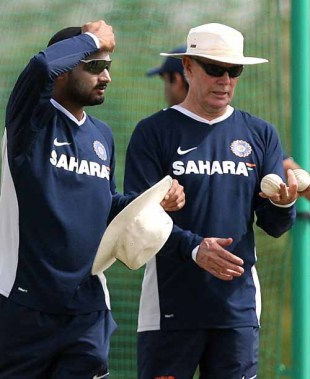The lost boys
Once heralded as the next big brown hopes of spin, Danish Kaneria and Harbhajan Singh now find themselves losing the magic that made them great
Osman Samiuddin
14-Dec-2007
|
|

|
Shane Warne has gone, Anil Kumble and Muttiah Muralitharan will go soon: cherish
them while you can, for a greater trio of spinners, twirling together in one age,
you will not see, perhaps ever.
Cherish them especially because beyond them, though good spinners exist, great ones
aren't obvious. Stuart MacGill's future has become bleak, as quickly as it became
tangible, Daniel Vettori has captaincy to tackle, and Monty Panesar much to learn.
And there are Danish Kaneria and Harbhajan Singh, a pair from whom were once expected great things, not least spin leadership post-Warne, Murali and Kumble.
They fit the profile. Both are still young, Harbhajan about six months older at 27. They
are experienced enough. Kaneria made his debut over two and a half years after
Harbhajan, in December 2000, but with 51 Tests is only nine behind him. Between
them, they also have 468 Test wickets, shared almost equally. Yet, currently they
seem likelier to lead their art into numbing oblivion.
Part of the reason the India-Pakistan series was fizz-less was that Kaneria and
Harbhajan were so poor through it. Apart from a spell apiece, both carried the sting
of butterflies, devoid of threat, mystery or guile, and never more so than on the last
days in Delhi and Kolkata, days on which a spinner earns his bread. Quality spin
has never been - and never should be - as robotic, as automated and witless as these
two made it.
Sadly, it has been this way a while. Wickets are not the problem: Harbhajan took 10
and Kaneria 12 in the series, enough to maintain career averages comfortably. But increasingly, the wickets are taken at such expense, at such intervals, and mostly when it matters so little, that they are as useful as the appendix. All spinners buy wickets, but the best make sure they don't without a fair haggle.
It wasn't always this way. In 2000-01, Harbhajan was the kingpin,
Kumble out of the picture. And after devouring lambs early, over 2004-05 Kaneria
looked set to carry on the mischief of Abdul Qadir. But since then, odd spells and
periods apart, there has been broad decay, a disrobing of their mystiques.
Fittingly, their career figures are similar and so too the complexities fuelling
their fall.
Watching Harbhajan now is like watching the final, dark years of Saqlain Mushtaq,
after he had OD'ed on ODIs. The flight is gone, the doosra is the pehla
(first), and the whole process more rushed, more unthinking. It has served a purpose
over one day, not so much over five.
Doubts over his action haven't helped. Though he maintains a cool unconcern, having
the essence of your professional existence questioned can't be helpful. And neither
was the era of Greg Chappell, when there was less confidence - justifiably? - placed
in him than under Sourav Ganguly.
What role, too, did Harbhajan's finger injury at a crucial time in 2003 play, allowing Kumble to become India's main spinner again, and subsequently fogging up Harbhajan's role: once he was the spearhead, what exactly is he now? Kumble's sidekick or leading
spinner in his own right?
This uncertainty of roles has stunted Kaneria too. It's difficult to tell whether he
is a shock or stock bowler. Ideally, he should be able to switch, but much of the
work he has done over the last 18 months has been as part of an attack so light, it would
struggle to rid the crease of a feather.
|
|

|
Warne was great, but having Glenn McGrath with him made him greater still. Kaneria
propping up Mohammad Sami, Shahid Nazir and the obligatory crocked fast bowler is
one thing; Kaneria complementing Mohammad Asif, Umar Gul and Shoaib Akhtar another entirely.
Some say he experiments too much. It was once said of his googly, by Richie Benaud,
that it was the best-disguised he had seen. But he uses it so often now that the
Pakistan Post delivers it a day early to batsmen. And even South Africans picked it
without alarm recently, a death knell to the credibility of any wrong'un. Others
say he doesn't experiment enough. Very belatedly, he unveiled a promising, zippy
flipper in Delhi, only to barely use it again in the series.
He is, commendably and distressingly, self-sufficient, rightly proud to be where he
is, what he is, through his own making. But he also isn't keen on learning from
others, petulantly thinking it an admission, somehow, of weakness. Right now, maybe a
little advice, some mentoring would help. There is no shortage of his kind to call
upon.
Horrendous pitches have helped neither. It's not, as Kaneria says, that they don't
spin in the subcontinent; it is that they don't bounce, and though Harbhajan and he are different kinds, both thrive on bounce. Perhaps there are other, more complex factors,
altogether. Spinners, after all, are rarely uncomplicated cricketers. But spinners
also age well, so there is hope yet that they will emerge. India and Pakistan need
them to do so, but cricket needs them to do so even more.
Osman Samiuddin is the Pakistan editor of Cricinfo